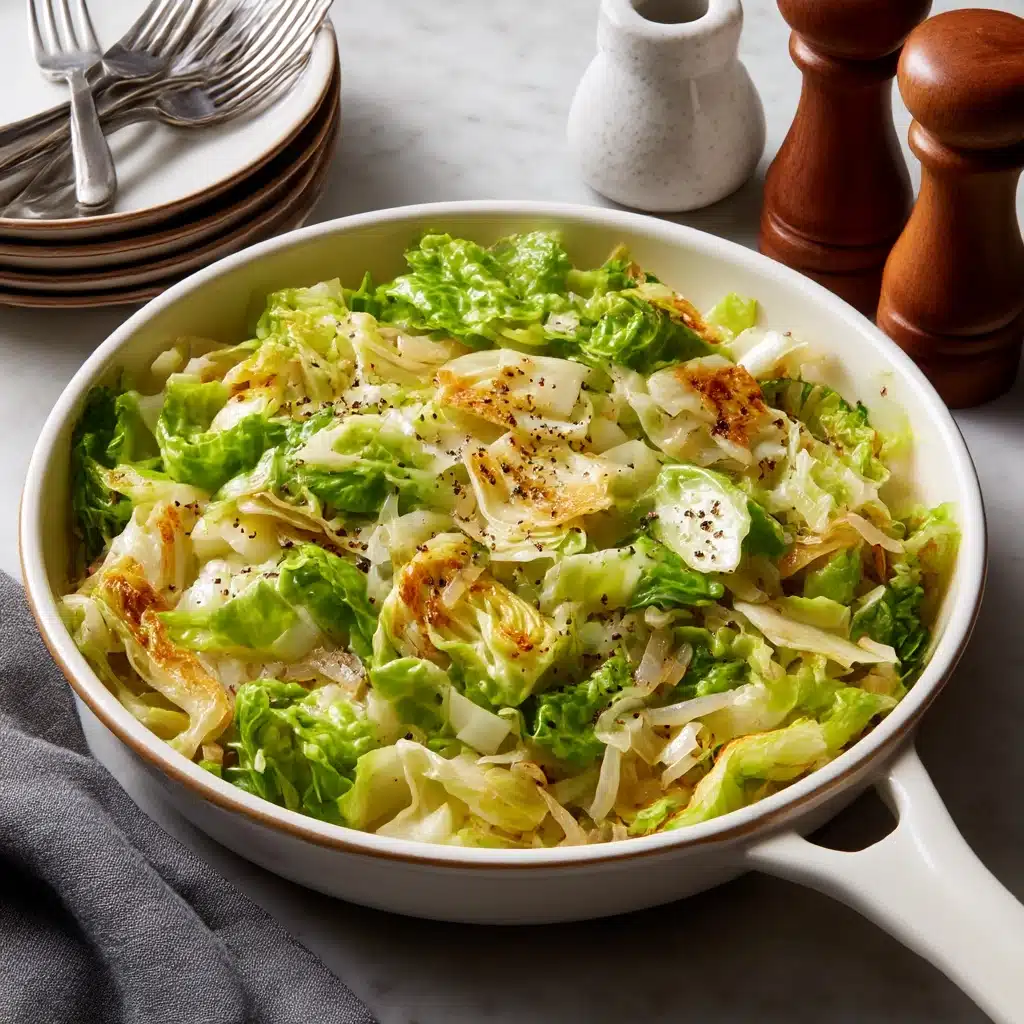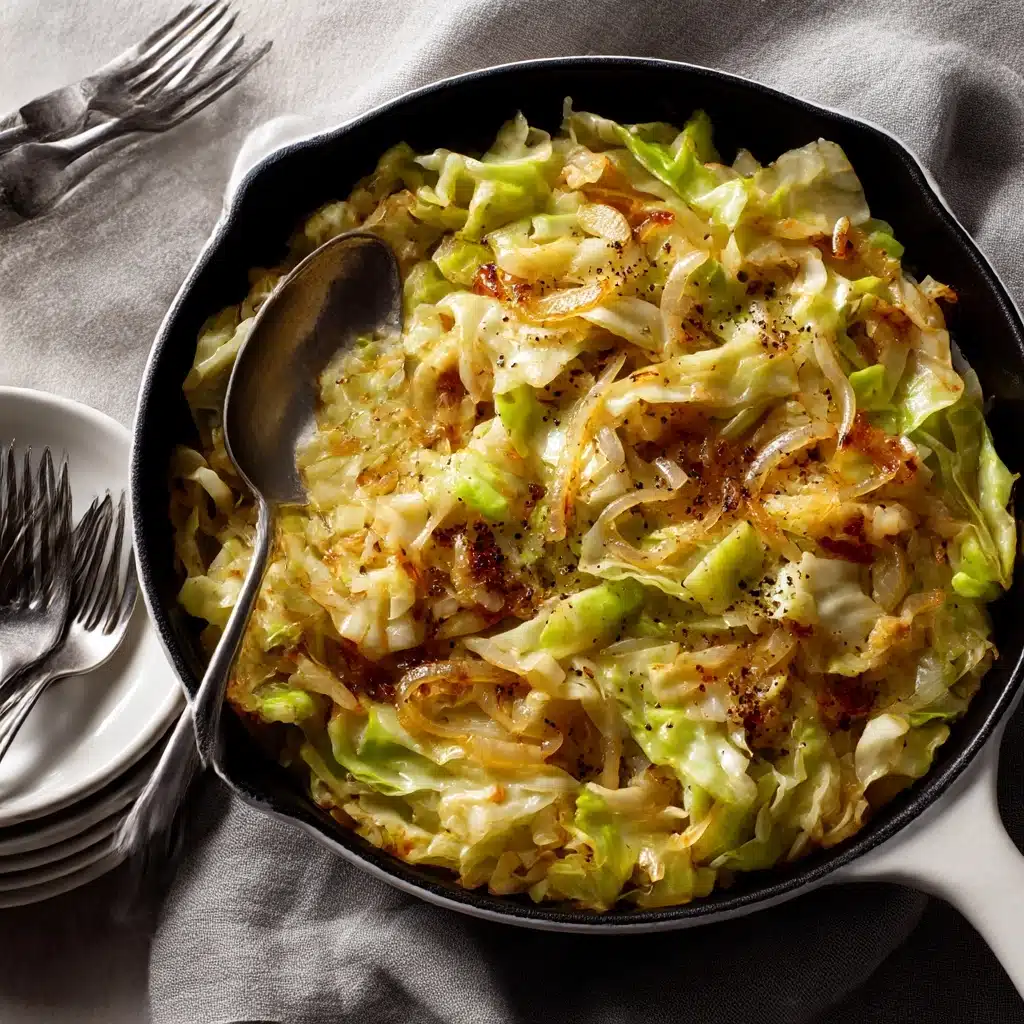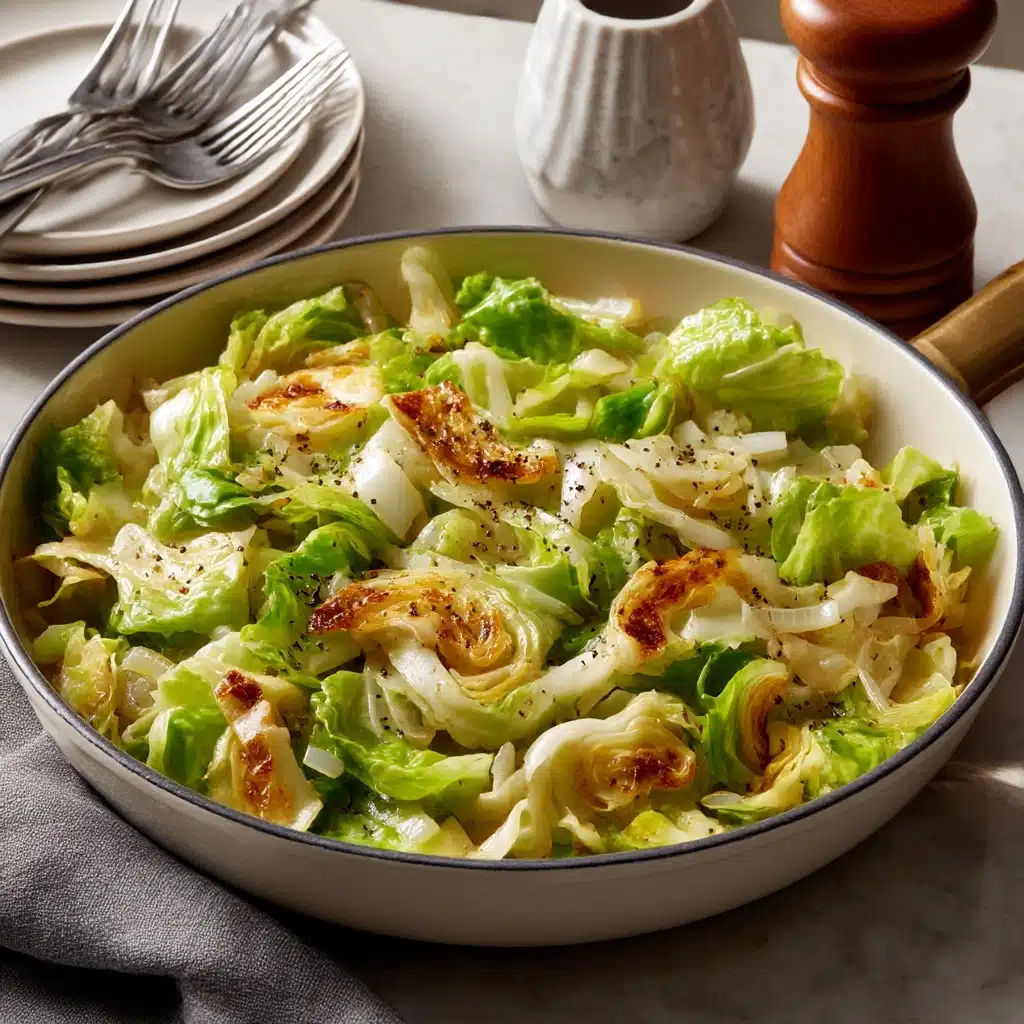If you’ve ever craved a veggie side dish that’s both outrageously simple and deeply satisfying, look no further than Sautéed Cabbage. This humble dish celebrates cabbage’s naturally sweet, earthy flavors and delivers a quick, golden tangle of tender greens, savory onions, and just a kiss of garlic. With every forkful, you’ll appreciate how this classic recipe proves that the secret to memorable food is often found in the simplest of preparations. Sautéed Cabbage is a side that seems to go with everything, and once you try it, you’ll want it to star on your table again and again.
Ingredients You’ll Need
One of the best things about Sautéed Cabbage is how it transforms a handful of everyday kitchen staples into something crave-worthy. Each ingredient has a clear purpose, building layers of robust flavor and irresistible texture, so don’t be tempted to skip anything—the magic is in the details!
- Green Cabbage: Go for a medium-sized head, cored and thinly sliced. It softens beautifully and caramelizes slightly as it cooks, becoming sweet and tender.
- Olive Oil or Butter: Both work wonderfully—olive oil for a lighter touch, or butter for richness. You can even use a blend!
- Yellow Onion: Thinly sliced onion adds mellow sweetness and depth, mingling perfectly with the cabbage.
- Garlic: Freshly minced garlic provides a subtle kick and uplifting aroma—just what the dish needs to shine.
- Salt: Simple seasoning goes a long way here, drawing out the cabbage’s natural flavors.
- Black Pepper: A pinch adds warmth and rounds out the dish.
- Red Pepper Flakes (optional): If you love a gentle hint of heat, sprinkle in a little for pleasant complexity.
- Apple Cider Vinegar or Lemon Juice (optional): Either option delivers a fresh burst of acidity that brightens and balances the whole pan.
How to Make Sautéed Cabbage
Step 1: Prepare Your Veggies
Start by thinly slicing your green cabbage and onion. Take your time here, as thinner slices mean more even cooking and those beautiful caramelized edges in the finished Sautéed Cabbage. Mince your garlic and have it ready—once things get moving on the stovetop, you’ll want everything at your fingertips.
Step 2: Heat the Pan
Place a large skillet on the stove over medium heat. Pour in the olive oil or add the butter, letting it melt until it starts to shimmer or froth just a bit. This step ensures you get that lovely sizzle when the vegetables hit the pan, which is key for infusing every bite with flavor.
Step 3: Sauté the Onion and Garlic
Add the sliced onion first and sauté for 3 to 4 minutes, stirring occasionally, until it softens and just begins to turn a golden hue. Next, stir in the minced garlic—let it cook for only about 30 seconds, just until fragrant. Be careful not to let the garlic burn.
Step 4: Cook the Cabbage
Now it’s time for the star! Add your sliced cabbage to the pan, tossing to coat everything evenly in that fragrant oil and onion mixture. Sprinkle with salt, black pepper, and, if you like, red pepper flakes for a little fire. Let the Sautéed Cabbage cook for 10 to 15 minutes, stirring occasionally. You’re looking for it to turn golden brown in spots and become deliciously tender, but still vibrant.
Step 5: Finish and Serve
Just before serving, add a tablespoon of apple cider vinegar or a squeeze of lemon juice if you like bright flavors. Give it a final toss and serve your Sautéed Cabbage warm, taking in the irresistible aromas wafting from the pan. This dish is truly as easy as it is tasty!
How to Serve Sautéed Cabbage

Garnishes
Dress up your Sautéed Cabbage with a sprinkle of fresh parsley, chives, or even a handful of toasted sunflower seeds for crunch. For more depth, try a light dusting of smoked paprika or a generous grind of black pepper on top.
Side Dishes
This cabbage is a flexible sidekick, cozying up to roasted meats like pork, chicken, or beef. It’s equally at home with grain bowls, spooned over fluffy rice, or paired with a hearty lentil stew. For a vegetarian meal, tuck it into a warm pita with a dollop of Greek yogurt.
Creative Ways to Present
Turn Sautéed Cabbage into the star by piling it onto toasted bread, nestling it next to eggs for a homey brunch, or mixing it with crispy potatoes for a hash. Leftovers? Try folding them into an omelet or tossing into noodle salads for a pop of silky flavor.
Make Ahead and Storage
Storing Leftovers
If you’ve made plenty of Sautéed Cabbage, let any extras cool completely before transferring them to an airtight container. Stored in the refrigerator, they’ll keep for up to 4 days, ready for a quick reheat when you need a vegetable boost.
Freezing
Though cabbage sometimes changes texture after freezing, Sautéed Cabbage actually holds up decently in the freezer. Place cooled portions in freezer-safe bags or containers, remove as much air as possible, and freeze for up to 2 months. Thaw overnight in the fridge for the best results.
Reheating
When you’re ready for round two, reheat your cabbage gently in a skillet over low to medium heat, adding a splash of water or broth if needed to loosen it up. This will help bring back its tenderness without overcooking. Alternatively, a minute or two in the microwave (covered) will also do the trick.
FAQs
Can I use red cabbage instead of green?
Absolutely! Red cabbage works wonderfully in this recipe, lending a deeper color and a slightly earthier flavor. Just be aware that the cabbage may bleed a bit of color and have a slightly firmer bite, but it’s every bit as delicious.
How can I make Sautéed Cabbage more filling?
If you want a more substantial dish, try adding sliced mushrooms, chickpeas, or even diced smoked sausage to the pan. Any of these options will boost the protein content and make Sautéed Cabbage hearty enough for a main course.
What’s the best pan to use?
A large, heavy-bottomed skillet (like stainless steel or cast iron) is ideal. These pans distribute heat evenly, help with browning, and allow enough space for the cabbage to cook without steaming too much.
Are there ways to spice up the flavor?
Definitely! Play with spices like caraway seeds, cumin, smoked paprika, or a splash of soy sauce for umami. You can also toss in a handful of fresh herbs like dill or thyme right at the end for extra fragrance.
Is Sautéed Cabbage good for meal prep?
Yes! Sautéed Cabbage reheats beautifully and maintains its flavor and texture for several days. It’s perfect for making ahead to tuck into lunches, grain bowls, or quick dinners throughout the week.
Final Thoughts
It’s truly amazing how something as basic as Sautéed Cabbage can be so satisfying and versatile. Whether you’re looking for a quick side or a new way to love your veggies, this recipe is sure to become a staple in your kitchen. Give it a try and let this simple, flavorful dish surprise you!
PrintSautéed Cabbage Recipe
A simple and flavorful recipe for sautéed cabbage, a versatile and healthy side dish that can accompany various main courses or stand alone as a light meal. This dish is quick to prepare and offers a balance of savory, sweet, and tangy flavors.
- Prep Time: 10 minutes
- Cook Time: 15 minutes
- Total Time: 25 minutes
- Yield: 4 servings 1x
- Category: Side Dish
- Method: Stovetop
- Cuisine: American
- Diet: Gluten-Free, Vegetarian
Ingredients
Main Ingredients:
- 1 medium green cabbage, cored and thinly sliced
- 2 tablespoons olive oil or butter
- 1 small yellow onion, thinly sliced
- 2 cloves garlic, minced
- 1/2 teaspoon salt
- 1/4 teaspoon black pepper
Optional Ingredients:
- 1/4 teaspoon red pepper flakes
- 1 tablespoon apple cider vinegar or lemon juice
Instructions
- Heat the Skillet: Heat olive oil or butter in a large skillet over medium heat.
- Sauté Onion: Add sliced onion and sauté for 3–4 minutes until softened.
- Cook Garlic: Stir in garlic and cook for 30 seconds until fragrant.
- Add Cabbage: Toss in sliced cabbage, season with salt, pepper, and red pepper flakes if using.
- Cook Cabbage: Cook for 10–15 minutes until tender and lightly browned.
- Finish: Optionally, add apple cider vinegar or lemon juice before serving. Serve warm.
Notes
- Enhance flavor with smoked paprika or soy sauce.
- Pair with roasted meats or serve over rice for a vegetarian meal.
Nutrition
- Serving Size: 1 cup
- Calories: 90
- Sugar: 5g
- Sodium: 210mg
- Fat: 6g
- Saturated Fat: 1g
- Unsaturated Fat: 5g
- Trans Fat: 0g
- Carbohydrates: 9g
- Fiber: 3g
- Protein: 2g
- Cholesterol: 0mg




